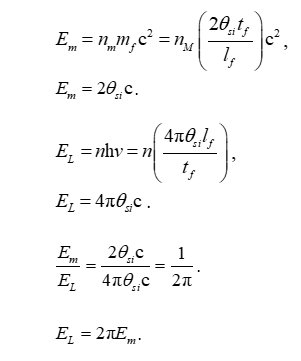What is the Physical Difference Between
Baryonic and Electromagnetic Phenomena?
In MQ Form
We resolve that the difference in energy between a fundamental unit of electromagnetic radiation and a fundamental unit of mass is 2pi.
Inputs
- h is Planck’s constant.
- ħ is the reduced Planck constant, 1.054571817 10-34 m2 kg s-1. When accounting for the Informativity differential at the upper count bound, this term is not italicized (i.e., ħ=1.0545349844(45) -34 m2 kg s-1).
- π is a numerical value describing the arc-distance of a circle of radius one.
Terms
- lf, mf and tf are the fundamental measures, more precise expressions for Planck’s units – length, mass, and time – that consider the effects of length contraction associated with discrete measure.
- θsi can be measured as the polarization angle of quantum entangled X-rays at the degenerate frequency of a maximal Bell state. As an angle θsi=3.26239 rad ± 2 μrad; as a momentum θsi=3.26239030392(48) kg m s-1 and with respect to the Target Frame, θsi has no units. The relation of angle and mass is mathematically demonstrated, as well, by No-Ping Chen, et. al.
- nM is the count of mf representing the mass corresponding to a gravitational field.
- QL is the fractional portion of a count of lf when engaging in a more precise calculation.
- nLr describes the count of lf representative of the position of an observable with respect to the frame of a center of mass.
- c is the speed of light which may also be written as c=nLlf/nTtf=299,792,458 m/s such that nL=nT=1 is physically significant.
- v is velocity measured between an observer and a target.
- m is an observed mass.
- El is the energy of one quantum of electromagnetic radiation.
- Em is the energy of half a fundamental unit of mass *mm.
Calculations
Discussion
Using the Measurement Quantization (MQ) approach to describing Einstein and Planck’s expressions for energy reveals a more fundamental correlation than presently resolved using Planck's expressions. The difference in a fundamental unit of energy with respect to each is 2π. This has always been interpreted, for instance, as the difference between the momentum and angular momentum of the respective phenomenon. MQ allows us to extend our understanding, distinguishing between the component measures lf, mf, and tf and the scalar and counts nL, nM and nT.
Writing each expression in terms of the MQ nomenclature - such that we account for the discrete features of measure with respect to the three frames of reference - the System and Internal Frames of the Universe and the Reference Frame of the observer - and such that Planck's expression is resolved as E=nhv, we find that n must be 1/2π. This is to say, that the count n is currently ascribed an angular description of one full circle. We ask, is such a description a physical or geometric property of the phenomenon?
With MQ, we have the opportunity to step back and look at each of the two descriptions using a physically shared nomenclature lf, mf, and tf, resolved as an emergent property of the expanding frame of the universe. Reducing each of the energy expressions to the fundamental measures we can now ask questions which before did not lead to definitive physical conclusions.
For example, note that the energy of a fundamental unit of mass is Em=2θsic. Such that 2θsi is the radial rate of expansion for the universe HU, and c is the rate of expansion relative to a point on its leading edge, we find that the energy of a fundamental unit of mass is a product of the expansion parameter over the perimeter velocity times the age of the Universe AU. The expression describes what the mass reference looks like using terms that describe the expansion of our universe as observed.
Additional insights are offered in the noted preprint. The paper resolves, specifically, the difference as a quality associated with the Internal and System Frames. Depending on which frame is considered, a phenomenon inherits different local properties. The difference between these frames also derrives expressions and values for the physical constants and the laws of nature.
Quantum Inflation, Transition to Expansion, CMB Power Spectrum




